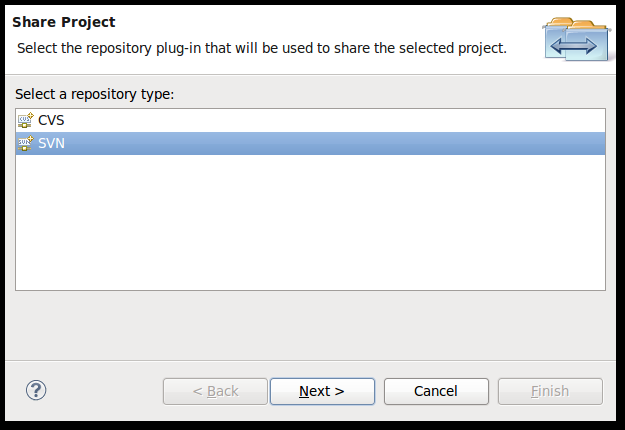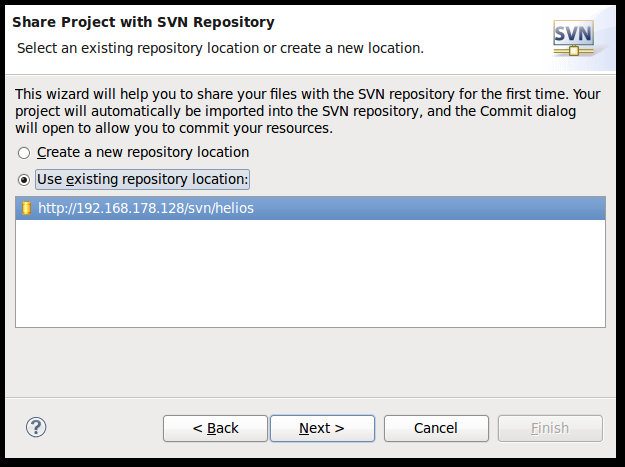<style type="text/css">
<!--
@page { margin: 2cm }
P { margin-bottom: 0.21cm }
H1 { margin-bottom: 0.21cm }
H1.western { font-family: "Times New Roman", serif }
H1.cjk { font-family: "DejaVu Sans" }
H1.ctl { font-family: "DejaVu Sans" }
A:link { so-language: zxx }
CODE.cjk { font-family: "DejaVu Sans", monospace }
-->
</style>
A
stock Eclipse installation has integrated support for CVS, a popular
open source change-management system. The abilities of CVS, and its
limitations, are well known, but many groups have been investigating
other version-control systems to provide better scaling, better
support for merging changes and branching versions, and better
support for binary file formats.
Subversion
(SVN) is a popular replacement for CVS, offering improved performance
(courtesy of intelligent local caching and a database back end), easy
and fast branching, and an answer to every one of the shortcomings
that people often run into while using CVS.
Read
on to see how to add Subversion support to Eclipse and how to perform
basic version-control activities from the IDE.
Before
you start
You're
going to need to download and install Eclipse
to follow along.
You'll
also need access to a Subversion repository. For demonstration
purposes, I'll show you how to check out the Subclipse project and
work with projects in a repository on my LAN.
Adding Subclipse to
Eclipse
Subclipse
is a project to add Subversion support to the Eclipse IDE. The
software is released under the Eclipse
Public License (EPL) 1.0 open source license. Read Download
and Install to see how to add subclipse to Eclipse.
Tips:In
addition, if you are on Linux, your distribution might only support a
specific version of Subversion and JavaHL. So you might want to
stick with a specific version of Subclipse for that client. More
information on how to get JavaHL, and the right version for each
version of Subclipse can be found in the
wiki .
A quick test
It's
always nice to test a new feature once you've finished the
installation; we'll try checking out a copy of Subclipse from a
Subversion repository to make sure it's been properly installed.
From
Eclipse's File menu, choose Import to display the import
manager (see Figure 1). Choose Checkout Projects from SVN,
then click Next.
Figure 1. The import
manager

On
the Select/Create Location panel (see Figure 2), we need to create a
new location (since we don't have any configured yet), so click Next
to continue. If the Next button is disabled, switch to the Use
existing repository location option, then back to Create a new
repository location to enable the Next button.
Figure 2.
Creating a new repository location

In
the next section (see Figure 3), add the repository URL
(http://192.168.178.128/svn/helios/)
to the Url field, then click Next.
After a moment, Eclipse prompts you for user ID and password. If you
don't have an account, enter guest
for the user ID and a space for the password, check the Save Password
box, and click OK.
Figure 3. Add the
repository URL

Eclipse displays the
folders in the Subclipse repository (see Figure 4).
Figure 4. Subclipse
repository

Basic Subversion
operations
At
this point, we've installed Subclipse successfully, which added
support for Subversion servers to our Eclipse setup, and we've tested
Subclipse by downloading the current Subclipse source code from the
repository. Now we should look at doing something with our own code
and our own Subversion repository.
Adding a project to
the repository
To
add a new project to your Subversion repository, right-click the
project (in any of Eclipse's project views or the Navigator view) and
choose Team > Share Project from the menu. Eclipse displays
the Share Project dialog.
Figure 5. The
Share Project dialog

Select SVN from the
list of repositories currently supported by your Eclipse, then click
Next. The next dialog (see Figure 6) lets you choose an existing
repository location, or you can create a new one.
Figure 6.
Selecting a repository location

If
your repository is already listed (as you can see, I've added mine),
select it, and then click Next. If your repository isn't listed, add
it (see A quick test for instructions) and continue. The next dialog
(see Figure 7) lets you enter folder name in the SVN repository. Then
click Next
Figure 7. Adding a
project's contents

Figure
8. Adding a project's contents

分享到:





相关推荐
Subversion for Eclipse是一款集成在Eclipse开发环境中的版本控制系统,主要功能是帮助开发者管理代码的版本,实现团队协作。Subversion(简称SVN)是一种开源的版本控制系统,它能够跟踪文件和目录的变更,使开发者...
**Subversion for Windows with Apache 服务器安装指南** 在IT行业中,版本控制系统对于团队协作和代码管理至关重要。Subversion(简称SVN)就是这样一个强大的工具,它允许开发人员追踪和控制文件及目录的变更。本...
HOWTO: Subversion for Windows with Apache server - a beginner's guide
### 在Eclipse中使用Subversion--Subclipse #### 核心知识点概述 1. **Eclipse与变更管理系统**:Eclipse作为一个广泛使用的开源集成开发环境(IDE),自诞生之初就内置了对CVS的支持,而随着Subversion(SVN)等...
【Eclipse的Subversion插件Subclipse详解】 Subversion(SVN)是一种广泛使用的版本控制系统,它可以跟踪文件和目录的变化,允许团队成员协同工作。Eclipse IDE中的Subclipse插件为开发者提供了方便的Subversion...
idea无法连接svn(Can't use Subversion command line client)下载这个jar直接在idea的settings/subversion/use command and client 输入svn.exe的绝对路径
Subclipse是Eclipse的一个插件,允许用户直接在Eclipse环境中与Subversion进行交互,实现版本控制功能。 Subclipse1.4.7是该插件的一个版本,适用于Eclipse 3.x系列。这个版本可能包含了对Subversion 1.6或1.7的...
**使用SUBCLIPSE——针对ECLIPSE的SUBVERSION插件详解** Subversion(简称SVN)是一种广泛使用的版本控制系统,它提供了比CVS更先进的功能,如版本化的文件重命名、目录操作以及元数据版本控制。SVN还支持原子提交...
在使用Subversion(通常简称为svn)作为版本控制系统时,可能会遇到“Can't use Subversion command line client: svn”这样的错误。这个错误通常表明系统无法找到或访问到svn的命令行客户端工具,这对于进行诸如...
Subversion Eclipse Connector,简称为SvnEclipse,是专为Eclipse集成开发环境设计的一款插件,它使得Eclipse用户能够无缝地与Subversion版本控制系统进行交互。Subversion(SVN)是一款开源的版本控制系统,用于...
"Publish to Subversion repository" 插件,即svn publisher插件,是Jenkins为了方便用户将构建结果发布到SVN仓库而设计的一款实用工具。本文将详细介绍这款插件的功能、使用方法以及其在Jenkins工作流中的重要性。 ...
### Eclipse操作Subversion详解 #### 一、与资源库同步 在进行开发工作时,团队成员需要保持代码的一致性和最新性。通过Eclipse集成的Subversion插件(如Subclipse),可以方便地实现与SVN仓库之间的同步操作。 1...
The document you are currently reading contains a lot of general information about converting from CVS, and specifically how to use cvs2svn to convert your repository to Subversion. cvs2git....
1. 集成IDE:如Eclipse、IntelliJ IDEA等支持Subversion插件,提供直观的版本控制操作。 2. CI/CD工具:与持续集成工具如Jenkins、GitLab CI/CD集成,实现自动化构建和部署。 3. 问题追踪系统:如JIRA,可与...
火龙果软件工程技术中心 本文内容包括:开始之前将Subclipse添加到Eclipse基本的Subversion操作结束语参考资料从一开始,Eclipse便包含了与ConcurrentVersionsSystem(CVS)的紧密集成,以便提供具有变更管理能力的...
The book titled "Eclipse in Action" provides a detailed guide for web developers on how to effectively use the Eclipse Integrated Development Environment (IDE). The authors, David Gallardo, Ed ...
本文将详细介绍如何利用Subversion(简称SVN)作为版本控制系统以及Apache Maven(简称Maven)作为构建管理工具来构建Java项目。 #### SVN简介 Subversion(SVN)是一种开源版本控制系统,它通过记录文件及目录的...
This allows you to recover older versions of your data or examine the history of how your data changed. In this regard, many people think of a version control system as a sort of “time machine.” ...